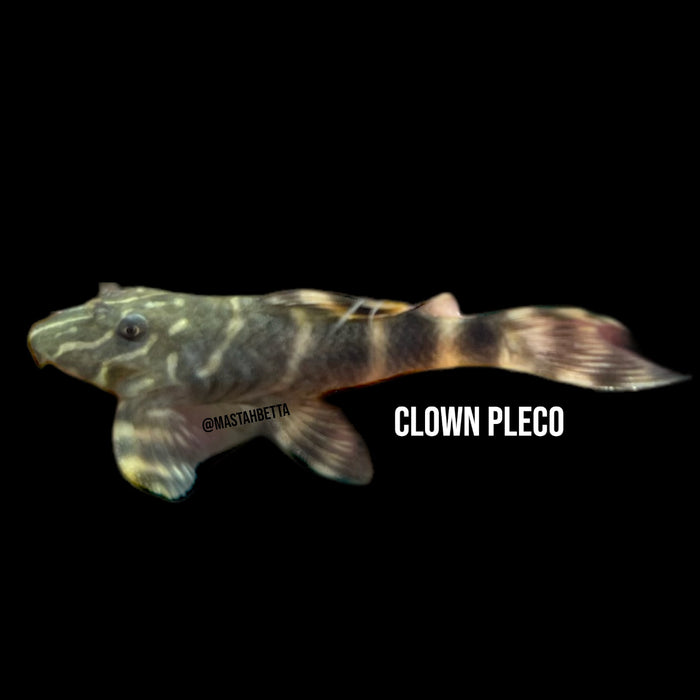
Clown Pleco
Clown Pleco for sale Online
Clown Pleco for sale Hawaii
Clown Pleco for sale near me

Clown Pleco for sale Online
Clown Pleco for sale Hawaii
Clown Pleco for sale near me
Name: Clown Pleco
Max Size: Up to 4 inches (10 cm)
Recommend pH: 6.5-7.5
Recommended Temperature (°F): 75-82°F (24-28°C)
Diet: Clown Plecos are primarily herbivorous, and their diet should consist of a variety of plant-based foods. They will feed on algae growing in the aquarium, but it's essential to supplement their diet with high-quality sinking pellets or wafers specifically formulated for herbivorous fish. They also appreciate blanched vegetables such as zucchini, cucumber, and spinach. Occasional offerings of live or frozen foods like bloodworms or brine shrimp can be provided as a treat.
Temperament: Peaceful
Schooling or Non-Schooling Fish: Non-Schooling Fish (Clown Plecos are solitary by nature and prefer to have their own territory. They can be kept individually or in small groups as long as there is enough hiding spaces and territory for each individual.)
Possible types of tank mates: Clown Plecos are peaceful and can be kept with other peaceful community fish. They are compatible with a wide range of species such as tetras, rasboras, peaceful cichlids, and other non-aggressive bottom-dwelling fish. Avoid keeping them with aggressive or fin-nipping fish that may stress or harm them.
Behavior: Clown Plecos, also known as Panaqolus maccus, are small and intriguing catfish that add a unique touch to the aquarium. They have a distinct pattern of bold black and white stripes, resembling a clown's attire, which gives them their name. Clown Plecos are primarily nocturnal and spend most of their time hiding in crevices or under driftwood and rocks. They are peaceful and generally shy, but once acclimated to their environment, they become more active during feeding times. They are adept at clinging to surfaces using their sucker-like mouth, allowing them to explore and feed on algae-covered surfaces.
Fun Fact: Clown Plecos are native to the Amazon River basin in South America. Despite their small size, they have a unique adaptation known as dermal teeth, which are specialized bony plates on their bodies. These teeth-like structures provide protection against predators and also aid in anchoring themselves to surfaces. Additionally, Clown Plecos are known for their ability to change coloration, especially when stressed or during breeding periods. Their color can range from a dark black and white pattern to a lighter tan or even orange hue. This adaptability and their charming appearance make Clown Plecos a popular choice among aquarists.
Perhaps the best store on island to get freshwater fish. They have a huge variety, including higher end freshwater fish (discus, puffers, flowerhorns , oddballs, ect) I’ve stocked a few tanks with their fish. They quarantine well and keep it real on how their fish are doing in shop.
Mr. Ali
Had a great experience here. I was looking for a unicorn/alicorn betta and spoke with the owner, Josh, about it. I ended up using his fish importing services to import a fish from Jakarta, and he brought in a few more white opaque or unicorn type half moon bettas too, to add to the variety in store. I got a sneak peak of the store while it was shut down for one week for a proper quarantine of its new fish. The owner knows his fish and keeps them healthy. A very different experience from a Petco or PetSmart! A Petco employee even recommended I go here for more unique betta fish. Note that they carry other types of fish too, plus Aquatic plants and some aquarium equipment. Pictured are some of the giant bettas, the alicorn betta, and i believe a beautiful ram.
Fawn B.
Wonderful shop with lots of variety. Has the most unique selection of fish on the island, and at a reasonable price! Staff is friendly and very helpful when we have questions or concerns. Love coming here and seeing the jokes around the store. Also, Vinnie!
Ian H.
The owner, Josh, is not just knowledgeable about the fish, but also plants and tank issues. I am new to fish tanks and he has been extremely helpful in answering my questions and offering suggestions to make my experience easier. Parking is a bit tricky, but certainly worth it.
Mark M.
They have rare plants you can't find at most places. Got lucky we got a few; my husband is happy. This is one of his favorite places. They get pretty busy, so be patient. The staff are very helpful.
Mr. Chin
Our online catalog is stocked with a wide variety of fresh water fish and Plants!
{"one"=>"Select 2 or 3 items to compare", "other"=>"{{ count }} of 3 items selected"}